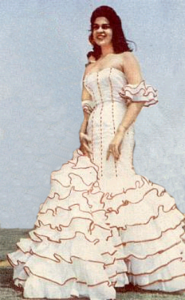 LA BATA CLASICA CUBANA, UNA PRENDA DE VESTIR DE LARGA VIDA.
LA BATA CLASICA CUBANA, UNA PRENDA DE VESTIR DE LARGA VIDA.
El vestuario tradicional cubano deviene derivación de prendas de vestir procedentes de España, con arreglos propios del ingenio y las necesidades de la población criolla.
Y en la confección de tales piezas, entre otras, dedicaban gran parte del tiempo nuestras mujeres de la época colonial; para ello se entrenaban desde niñas, pues tales labores constituían más un entretenimiento que un trabajo.
La escritora cubana Renée Méndez Capote dejó constancia de la fascinación que las niñas experimentaban por las batas, “privilegio exclusivo de las señoras casadas, aquellas batas criollas que en los escenarios de la época (teatro vernáculo, zarzuela y cabaret), en su afán de equivocada estilización, lo acercó más al folklore andaluz que a nuestra tradición.
Se trata de la bata clásica: una pieza auténtica, de fino holán de hilo enriquecida por alforcitas, aplicaciones, vuelos y bordados, con sus largas mangas perdidas y la moña de cinta prendida al final del escote moderado.
Interesantes resultan la experiencias de la visita a Cuba, en 1864, el pintor británico Walter Goodman, quien dejó constancia del uso común de la bata como prenda doméstica, pues, cuando la esposa de Don Benigno, su anfitrión santiaguero, lo recibe en su casa, “se envuelve en una bata suelta de hilo que cae como un saco, sin cinturón, ininterrumpidamente, desde sus hombros hermosos a sus zapatos notables por la pequeñez”.
Durante la colonia, la vestimenta en Cuba estaba orientada por la moda europea, recibida esta a través de la metrópoli.
A partir de mediados del siglo XIX, se evidenciaron rasgos en el vestir de las criollas y criollos, que propiciaron el desarrollo de ciertas particularidades que abarcaron una manera de vestir “a la cubana”, como revelación de su identidad en la sociedad.
En tanto en Cuba se contaba con máquinas de coser de carácter industrial, y, más tarde, de uso doméstico. En 1857, a pocos años de creada la patente Singer, se estableció en La Habana el primer taller de confección a máquina.
Si bien las mujeres cubanas tenían la opción de realizar sus compras en Europa, incluso en París; en Cuba existían condiciones adecuadas para la adquisición de gran variedad de textiles y la confección de la indumentaria.
La vestimenta de las criollas y su predilección por el color blanco dejaban atrás su empleo por las damas europeas, que seguían la moda francesa de la época.
En la actualidad, estas maravillosas batas gustan a cubanos y extranjeros, y los artesanos ofrecen una amplia variedad de tan singular vestido agradable al clima antillano.
No es común ya su uso, y solo aparece en celebraciones muy especiales y escenificaciones de teatro y la danza, inspiradas en el vestuario femenino de la isla mayor de las Antillas.
 THE CUBAN CLASSIC BATA, A DRESS WITH A LONG LIFE.
THE CUBAN CLASSIC BATA, A DRESS WITH A LONG LIFE.
The traditional Cuban clothing becomes derivation of clothing from Spain, with arrangements of the ingenuity and the needs of the Creole population.
And in the preparation of such pieces, among others, our women of the colonial era spent much of their time; For this, they trained since they were girls, because such tasks constituted more entertainment than work.
The Cuban writer Renée Méndez Capote recorded the fascination that girls experienced in gowns, “the exclusive privilege of married ladies, those Creole gowns that were on stage at the time (vernacular theater, zarzuela and cabaret), in their eagerness to Wrong stylization, brought it closer to Andalusian folklore than to our tradition.
This is the classic robe: an authentic piece, made of fine holán of yarn enriched by saddlebags, applications, flights and embroidery, with its long lost sleeves and the ribbon bow attached at the end of the moderate neckline.
Interesting are the experiences of the visit to Cuba, in 1864, the British painter Walter Goodman, who recorded the common use of the gown as a household garment, because, when Don Benigno’s wife, his Santiago host, receives him at home “She wraps herself in a loose robe of yarn that falls like a sack, without a belt, uninterruptedly, from her beautiful shoulders to her remarkable shoes for smallness.”
During the colony, the clothing in Cuba was oriented by European fashion, received through the metropolis.
From the mid-nineteenth century, features were evident in the dress of Creoles and Creoles, which led to the development of certain peculiarities that included a way of dressing “the Cuban”, as a revelation of their identity in society.
While in Cuba there were sewing machines of an industrial nature, and, later, for domestic use. In 1857, a few years after the Singer patent was created, the first machine-made workshop was established in Havana.
Although Cuban women had the option of making their purchases in Europe, even in Paris; In Cuba there were adequate conditions for the acquisition of a wide variety of textiles and the making of clothing.
The clothes of the Creoles and their predilection for the white color left behind their employment by the European ladies, who followed the French fashion of the time.
Today, these wonderful gowns like Cubans and foreigners, and artisans offer a wide variety of such a unique dress that is pleasant to the West Indian climate.
Its use is no longer common, and it only appears in very special celebrations and theater and dance performances, inspired by the feminine costumes of the greater island of the Antilles.
Agencies/ RHC/ Guadalupe Yaujar/ Internet Photos/ Arnoldo Varona/ www.TheCubanHistory.com
THE CUBAN HISTORY, HOLLYWOOD.









